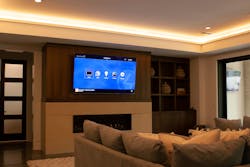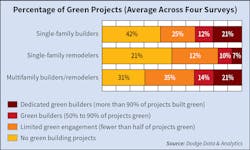What makes a smart home smart? A security system? Automated lighting and window shades? An irrigation system that detects leaks? Surround sound throughout? Voice-controlled HVAC? All of the above — and then some. That depth and breadth is filled with revenue and market-differentiation opportunities for electrical contractors. But capitalizing on those opportunities requires understanding the different reasons why homeowners and builders are using the technologies, as well as the interplay with other trades, such as plumbers and HVAC technicians.
“Everybody wants to keep track of one of their biggest investments,” says Stephen Edwards, director of sales and operations at Lenexa, Kan.-based Teague iCtrl, a division of Teague Electric. “So cameras are a hot commodity right now, whether that be a smart doorbell or some cameras integrated around [the home].”
Recent market studies concur
“Safety is a key driving force in the smart home category,” says the Consumer Technology Association’s (CTA’s) January 2020 U.S. Consumer Technology Sales and Forecasts report. “CTA expects smart home sales — including smart doorbells and locks, Wi-Fi cameras, smart thermostats, smart smoke and carbon monoxide detectors, and smart home security kits — to reach 35.2 million units (15% growth) and $4.3 billion (4% increase).”
Those numbers could be even bigger because the smart home sector overlaps with other consumer markets. For example, smart speakers like Amazon Alexa can also be used to control smart home systems, such as networked lighting. The CTA report predicts the smart speaker market will grow 14% this year to $4.2 billion.
Although younger, tech-savvy demographics such as Millennials and Gen Xers might seem like the prime buyers of smart homes, there are ample opportunities with retirees, too. For instance, simply saying, “Alexa, turn up the heat to 70” or “Okay, Google, turn on the outside lights,” can be attractive to someone whose rheumatoid arthritis makes it difficult to walk, flip switches, or push thermostat buttons. That convenience is why the smart home market includes senior living communities. For example, Sun Health’s La Loma Village in Litchfield Park, Ariz., has smart speakers throughout each residence for controlling lighting, heating, and cooling.
Even so, the smart home market isn’t immune to the impact of the recent COVID-19 outbreak. The research firm Omdia, for example, recently revised its global 2020 forecast from $120.6 billion down to $101.1 billion.
“In the Americas, the smart home device revenue outlook has been reduced by 10.6%,” Omdia says. “Device growth in the United States is forecast to remain stronger than other countries. Growth projections could be further reduced if stock markets do not rebound or if the virus spreads to influence U.S. supply chains.”
A broad service portfolio captures more of the market
Some smart homes monitor water usage to minimize waste, detect leaks, or both.
“We’re working on a project right now where the homeowner lives in the Bahamas, so he wants to keep track of everything that’s going on in his house,” Edwards says. “We have a smart water shutoff valve with sensors around the house. If it senses water, it will automatically shut the water main off, and send an alert to the homeowner. That’s in our bag of tricks. We work with the plumbing company to make sure they do that correctly because we’re not plumbers, but we can put the technology inside it.”
Some electrical contractors also offer plumbing and HVAC services. Those types potentially could capture a bigger share of smart home projects that span multiple systems. Another example is audio/video (AV) systems, which are a hot segment of the smart home market.
“I find that the first thing every consumer wants in a new home is some nice flat-screen TVs and speakers in the ceilings,” says John Moffitt, an Overland Park, Kan.-based Realtor and custom home builder for almost 40 years.
Typically, those are designed and installed by an AV integrator. Teague Electric is an example of how some electrical contractors are adding AV to their portfolio just as others have done with plumbing or HVAC.
“If I walk into a house, and there’s a half-million-dollar theater, and somebody says, ‘Who did this?’ and they say, ‘My electrical contractor,’ most AV integrators are going to scoff at that: ‘Oooh. Is it done correctly?’” Edwards says.
“We rebranded our low-voltage AV portion as Teague iCtrl. We now have a dedicated staff who strictly focus on all these different needs from the AV perspective versus the high-voltage side of things.”
Televisions also can double as control panels for smart home systems, whether it’s for the entire house or just the home theater. For example, motorized window shades are a way to overcome the ambient light that would otherwise wash out the TV. Motorized shades also can be programmed to close when there’s direct sun, so the AC doesn’t have to work as hard.
“A lot of customers are doing motorized shades,” Edwards says. “It’s a really hot item. That gets brought into this same ecosystem.”
Standing out from the pack
Hot markets often attract outsiders who parachute in looking to grab a share. Smart homes are no exception. Certification is one way to stand out in the eyes of homeowners and general contractors, such as with staff who have LEED accreditations. Another option is certification for one or more segments of the smart home market. For example, out of the 40-odd AV companies in metro Kansas City, Teague iCtrl is one of just three certified by the Home Technology Association (HTA).
“It takes anywhere from three to six months to get vetted,” Edwards says. “They call all your vendors. They call customers. They call builders.”
Some vendors offer certifications that carry weight in the eyes of other professionals, such as general contractors and architects.
Selling savings
Smart home budgets run the gamut, depending on what homeowners can afford and what they want to achieve.
“We’ve done houses where they spent $200,000-plus,” Moffitt says. “We’ve done houses where they spent $200. On a $300,000 [project], we’re going to have a much smaller budget — probably like $3,000 to $5,000 versus $20,000 to $30,000 [on a million-dollar home].”
One way to overcome budget constraints is by explaining the technology’s return on investment (ROI). When LED and CFL light bulbs debuted, they cost multiples more than incandescent ones. But many consumers bought them anyway because they knew they’d recoup the price premium through lower utility bills and longer life (at least with LEDs). The same strategy applies to smart home technologies — and not just the ones that improve energy efficiency.
“I create an ROI for customers: ‘You’re going to spend this much money up-front, but here’s your monthly savings,” Edwards says. “Instead of having a cable box on each TV, and spending $13/month per box, we have ways to eliminate or lower that cost. Everything we do is focused on saving them money.”
If the ROI is big enough, it could also encourage clients to expand the smart home portion of their budget because now they know roughly how much they’ll save and how long it will take reach a break-even point. In other cases, explaining the ROI of smart home technologies could convince clients who otherwise wouldn’t have considered them at all.
How much can homeowners reasonably expect to save? The amount varies significantly based on the applications, but a monthly average is $98.30, or $1,179.60 annually, according to a November 2019 Safe Smart Living report.
No matter how big or how small a client’s smart home budget is, one key to staying within it is getting the right input at the right time. For example, if the electrical contractor is taking the lead on the smart home systems, it needs a seat at the table when the architect and builder are hashing out the design and bid details. That advice sounds obvious, but it’s often not the case, which can result in expensive change orders.
“A lot of newer builders say, ‘We’ll put an allowance in here [for the smart home systems], and we’ll deal with it when we get there,’” Moffitt says. “They just want to get a contract signed.”
Moffitt frequently works with Teague iCtrl, a collaboration that includes making sure that all of the smart home systems are in the blueprints when they’re presented to the client for approval.
“iCtrl comes out after all of the other mechanicals have been in,” Moffitt says. “He’s the last guy in before we button it up with Sheetrock and insulation.”
Kridel is an independent analyst and freelance writer with experience in covering technology, telecommunications, and more. He can be reached at [email protected].
Sidebar: Going Green to Save Green
Saving money and the environment are two top reasons why homeowners and spec builders are dedicating part of their budgets to smart home technologies that use water and energy efficiently. According to the “2020 Green Single Family and Multifamily Homes SmartMarket Brief,” 33% of single-family builders and 35% of multi-family builders say at least half of their projects are green (see Chart).
Conducted by Dodge Data & Analytics in partnership with the National Association of Home Builders (NAHB), the survey found less activity in the remodeling market. Only 17% of single-family remodelers say that more than half of their projects are green, and 50% said they didn’t do any green projects in 2018.
But the remodeling market might be more fertile than those numbers suggest. One factor is whether a green remodeling project seeks a certification such as LEED. Many don’t — but still have four or five figures’ worth of a smart home budget.
“In this survey, green has a pretty rigorous definition, which includes certification,” says Jaclyn Toole, NAHB AVP for sustainability and green building. “Based on several of the national green programs, remodeling project certification are much lower than new construction. That said, we do find that upgrades and retrofits can focus on energy efficiency with a goal of lower utility bills. These retrofits and upgrades don’t typically get a certification [and] therefore aren’t accounted for in this survey.”
The NAHB study also found that state, federal and municipal regulations currently have little influence — as carrots or sticks — on whether builders and homeowners to go green.
“Currently, green residential projects are not mandated in many jurisdictions,” Toole says. “NAHB encourages jurisdictions to incentivize above-code green building programs like ENERGY STAR, NGBS Green Certification, etc.
“We have seen a trend in jurisdictions considering mandating solar for new residential projects. California was the first state to mandate solar, and we have heard of a few others considering it.”
In the wake of hurricanes and other major disasters, the U.S. Department of Housing and Urban Development’s Community Development Block Grants – Disaster Recovery (CDBG-DR) can be a positive factor.
“To be eligible for these funds, states must create and submit for approval an action plan,” Toole says. “Often in those plans, if a home that was damaged want to build back, they qualify for some of these CDBG-DR funds if they have a green or energy certification.”
In the NAHB study, low customer demand and a high price premium were the No. 1 and No. 2 reasons why single-family builders and remodelers aren’t building green. Number 3 was a lack of skilled green workers, which could indicate opportunities for electrical contractors to fill that void.
“Having electrical contractors understand how home energy management systems work, what components go into them, and what is best for each housing type would give the builder and architect an additional resource to consult,” Toole says. “Knowing the requirements of certifications for the National Green Building Standard (NGBS Green), ENERGY STAR, and LEED can help electrical contractors understand how the work they do has the potential to impact, positive or negative, the requirements for certification. For instance, the number of electrical boxes and wires, and locations, can negatively impact the insulation installation, which is a large part of green certification.”
About the Author
Tim Kridel
Freelance Writer
Kridel is an independent analyst and freelance writer with experience in covering technology, telecommunications, and more. He can be reached at [email protected].



